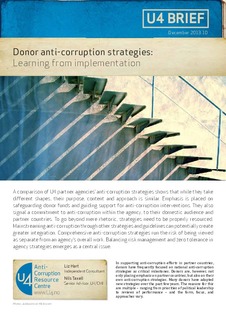| dc.contributor.author | Hart, Liz | |
| dc.contributor.author | Taxell, Nils | |
| dc.date.accessioned | 2018-01-04T08:18:16Z | |
| dc.date.available | 2018-01-04T08:18:16Z | |
| dc.date.issued | 2013-12-19 | |
| dc.identifier | oai:www.cmi.no:5002 | |
| dc.identifier.citation | Bergen: Chr. Michelsen Institute (U4 Brief 2013:10) 6 p. | |
| dc.identifier.uri | http://hdl.handle.net/11250/2474851 | |
| dc.description.abstract | A comparison of U4 partner agencies’ anti-corruption strategies shows that while they take different shapes, their purpose, content and approach is similar. Emphasis is placed on safeguarding donor funds and guiding support for anti-corruption interventions. They also signal a commitment to anti-corruption within the agency, to their domestic audience and partner countries. To go beyond mere rhetoric, strategies need to be properly resourced. Mainstreaming anti-corruption through other strategies and guidelines can potentially create greater integration. Comprehensive anti-corruption strategies run the risk of being viewed as separate from an agency’s overall work. Balancing risk management and zero tolerance in agency strategies emerges as a central issue. | |
| dc.language.iso | eng | |
| dc.publisher | Chr. Michelsen Institute | |
| dc.relation | U4 Brief | |
| dc.relation | 2013:10 | |
| dc.relation.ispartof | U4 Brief | |
| dc.relation.ispartofseries | U4 Brief 2013:10 | |
| dc.relation.uri | https://www.cmi.no/publications/5002-donor-anti-corruption-strategies | |
| dc.subject | Aid | |
| dc.subject | Donors | |
| dc.subject | Anti-Corruption Strategies | |
| dc.subject | Risk Management | |
| dc.subject | Zero Tolerance | |
| dc.title | Donor anti-corruption strategies: Learning from implementation | |
| dc.type | Report | |
